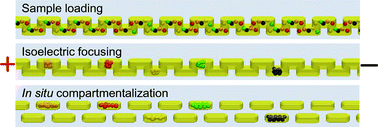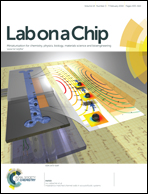Droplet-based in situ compartmentalization of chemically separated components after isoelectric focusing in a Slipchip†
Abstract
Isoelectric focusing (IEF) is a powerful and widely used technique for protein separation and purification. There are many embodiments of microscale IEF that use capillary or microfluidic chips for the analysis of small sample volumes. Nevertheless, collecting the separated sample volumes without causing remixing remains a challenge. Herein, we describe a microfluidic Slipchip device that is able to efficiently compartmentalize focused analyte bands in situ into microdroplets. The device contains a microfluidic “zig-zag” separation channel that is composed of a sequence of wells formed in the two halves of the Slipchip. The analytes are focused in the channel and then compartmentalised into droplets by slipping the chip. Importantly, sample droplets can be analysed on chip or collected for subsequent analysis using electrophoresis or mass spectrometry for example. To demonstrate this approach, we perform IEF separation using standard markers and protein samples, with on-chip post-processing. Compared to alternative approaches for sample collection, the method avoids remixing, is scalable and is easily hyphenated with the other analytical methods.


 Please wait while we load your content...
Please wait while we load your content...